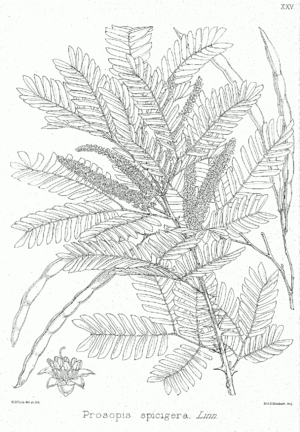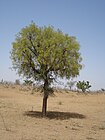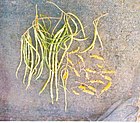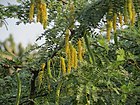Note: This is a project under development. The articles on this wiki are just being initiated and broadly incomplete. You can Help creating new pages.
Prosopis cineraria - Indian mesquite
Shami is a moderate sized throny tree with bipinnate leaves distributed from Iran to India. Within India, it is found in the dry and arid regions on the alluvial plains.
Uses
Parts Used
Chemical Composition
Common names
| Language | Common name |
|---|---|
| Kannada | banni mara, perumbe |
| Hindi | khejri, sami, chonkar, jhand |
| Malayalam | paramba |
| Tamil | parambai, Vanni, kulivam, tamali |
| Telugu | Jammi, priyadarshini, chamee |
| Marathi | NA |
| Gujarathi | NA |
| Punjabi | NA |
| Kashmiri | NA |
| Sanskrit | Shami, shiva, lakshmi ,mangalya, shankhuphala, Saktuphala, |
| English | Shami tree |
Properties
Reference: Dravya - Substance, Rasa - Taste, Guna - Qualities, Veerya - Potency, Vipaka - Post-digesion effect, Karma - Pharmacological activity, Prabhava - Therepeutics.
Dravya
Rasa
Kashaya (AStringent), Madhura (Sweet)
Guna
Laghu (Light), Rooksha (Dry)
Veerya
Sheeta (cold)
Vipaka
Katu (Pungent)
Karma
Pitta, Kapha
Prabhava
Habit
Identification
Leaf
| Kind | Shape | Feature |
|---|---|---|
| Bipinnate | alternate | Leaves 1-3-jugate, glabrous or puberulous; petiole and rachis 0.5-4 cm long, the pinnae 2-7 cm long; leaflets 7-14-jugate, ovate, straight to subfalcate, without nerves (or 2-4-nerved at base, the midrib excentric), mucronate, 4-15 mm long x 2-4.5 mm broad, greyish when dry; stipules foliaceous, deciduous. |
Flower
| Type | Size | Color and composition | Stamen | More information |
|---|---|---|---|---|
| Bisexual | spiciform racemes | Pale yellow | 5-13 cm long, several together, subpaniculate; peduncle with amplexicaul bract (or 2 bracts united), this caducous and leaving an oblique scar, 1.5-2 mm long; bractlets ovate, sessile, 0.5-0.8 mm long, caducous; pedicels 0.5 mm, to 1.5 mm long when mature; flowers yellow, glabrous; calyx truncate, 0.8-1.2 mm long; corolla 3.5 mm long, glabrous, the petals rolled back in age; anthers 0.8-1 mm long; pistil
glabrous. |
Fruit
| Type | Size | Mass | Appearance | Seeds | More information |
|---|---|---|---|---|---|
| A Pod | 8 - 9 cm long | Fruit slender, elongate, 8-19 cm long (including the stipe 0.8-2 cm), subcylindric-torulose, 4-7 mm in diameter, glabrous; pericarp thin, brittle; endocarp segments thin, longitudinal, little developed; seeds distant, longitudinal, ovate, 6 mm long, the tegument with open horse-shoe fissural line on faces, 10-15 in a pod, brown. | seeds 6-15, 8-10 x 7-9 mm, glossy, red | {{{6}}} |
Other features
List of Ayurvedic medicine in which the herb is used
Where to get the saplings
Mode of Propagation
How to plant/cultivate
Season to grow
Soil type
Propagation
Commonly seen growing in areas
Photo Gallery
References
External Links
Categories:
- Ayurvedic Herbs known to be helpful to treat Skin diseases
- Ayurvedic Herbs known to be helpful to treat Cysts and tumours
- Ayurvedic Herbs known to be helpful to treat Cough
- Ayurvedic Herbs known to be helpful to treat Bronchitis and Asthma
- Ayurvedic Herbs known to be helpful to treat Piles
- Ayurvedic Herbs known to be helpful to treat Dysentery
- Ayurvedic Herbs known to be helpful to treat Diarrhea
- Herbs with Bark used in medicine
- Herbs with Fruits used in medicine
- Herbs with common name in Kannada
- Herbs with common name in Hindi
- Herbs with common name in Malayalam
- Herbs with common name in Tamil
- Herbs with common name in Telugu
- Herbs with common name in Sanskrit
- Herbs with common name in English
- Habit - Tree
- Index of Plants which can be propagated by Seeds
- Index of Plants which can be propagated by Cuttings
- Herbs that are commonly seen in the region of Tropical area
- Herbs
- Fabaceae
- Ayurvedic herbs that don't have seed photos






